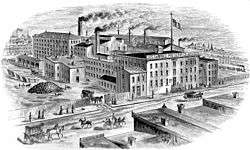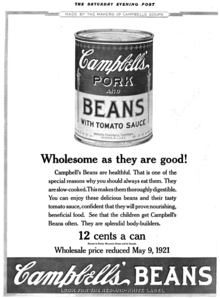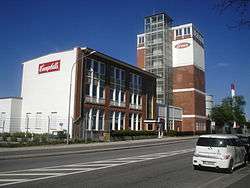Campbell Soup Company
 | |
| Public | |
| Traded as |
NYSE: CPB S&P 500 Component |
| Industry | Food processing |
| Founded | 1869 |
| Headquarters | Camden, New Jersey, US |
Key people |
Paul R. Charron (Chairman) Denise Morrison (President and CEO) |
| Products |
Campbell's Erasco Bolthouse Farms Pepperidge Farm Arnott's Pace StockPot V8 Liebig Royco |
| Revenue |
|
|
| |
|
| |
| Total assets |
|
| Total equity |
|
Number of employees | 17,500 (2011)[1] |
| Website |
www |



The Campbell Soup Company, also known as Campbell's, is an American producer of canned soups and related products. Campbell's products are sold in 120 countries around the world. It is headquartered[2] in Camden, New Jersey. Campbell's divides itself into three divisions: the simple meals division, which consists largely of soups both condensed and ready-to-serve, the baked snacks division, which consists of Pepperidge Farm, and the health beverage division, which includes V8 juices. Campbell's runs a program for schools, Labels for Education.
History
The company was started in 1869 by Joseph A. Campbell, a fruit merchant from Bridgeton, New Jersey, and Abraham Anderson, an icebox manufacturer from South Jersey.[3] They produced canned tomatoes, vegetables, jellies, soups, condiments, and minced meats.
In 1876, Anderson left the partnership and the company became the "Joseph A. Campbell Preserve Company".[4]
Campbell reorganized into "Joseph Campbell & Co." in 1896. In 1897, John T. Dorrance, a nephew of the general manager Arthur Dorrance, began working for the company at a wage of $7.50 a week.[4][5] Dorrance, a chemist with degrees from MIT and Göttingen University, Germany, developed a commercially viable method for condensing soup by halving the quantity of its heaviest ingredient: water.[3] He went on to become president of the company from 1914 to 1930, eventually buying out the Campbell family.[6]
In 1898, Herberton Williams, a Campbell's executive, convinced the company to adopt a carnelian red and bright white color scheme, because he was taken by the crisp carnelian red color of the Cornell University football team's uniforms.[7] To this day, the layout of the can, with its red and white design and the metallic gold medal seal from the 1900 Paris Exhibition, has changed very little, with the exception of the French phrase on the top of the gold seal that said "Exposition-Universelle-Internationale" which was changed to the English name of the exhibition as "Paris International Exposition".
Campbell Soup became one of the largest food companies in the world under the leadership of William Beverly Murphy. He was elected executive vice president of Campbell Soup in 1949 and was President and CEO from 1953 to 1972. While at Campbell's Soup Company, he took the corporation public and increased its brand portfolio to include Pepperidge Farm's breads, cookies, and crackers, Franco-American's gravies and pastas, V8 vegetable juices, Swanson broths, and Godiva's chocolates. David Johnson was President and CEO from 1990 until 1997.
Campbell Soup invested heavily in advertising since its inception, and many of its promotional campaigns have proven value in the Americana collectible advertising market. Perhaps best known are the "Campbell Kids" designed by illustrator Grace Drayton.[3] Ronald Reagan was a spokesman for V8 when Campbell's acquired the brand in 1948.[8]
In addition to collectible advertising, the company has also had notable commercial sponsorships. Among these was Orson Welles's The Campbell Playhouse, which had previously been The Mercury Theatre on the Air. After the program's adaptation of The War of the Worlds became a sensation for accidentally starting a mass panic due to its realism, Campbell's took over as sponsor of the radio theater program in December 1938.
In the UK and Ireland, Campbell Soup was rebranded as Batchelors Condensed Soup (UK) and Erin (Ireland) in March 2008, when the license to use the brand name expired. Premier Foods, St. Albans, Hertfordshire bought the Campbell Soup Company in the UK and Ireland, for £450m ($830m) in 2006, but was licensed to use the brand only until 2008. Under this agreement, the US-based Campbell Soup Company continued to produce Campbell's Condensed Soup but could not sell the product in the UK for a further five years.[9]
Campbell's continues to be a major part of Camden, New Jersey, regularly participating in charity events[10][11] in the community. In 2009, Campbell's completed the building of a new and expanded headquarters[12] in the city.
In January 2010, Campbell's Canadian subsidiary began selling a line of soups that are certified by the Islamic Society of North America as being halal (prepared in accordance with Islamic law). Although Campbell does not have any plans to sell its halal soups in the United States, the move has drawn criticism from anti-Muslim critics in the United States. Blogger Pamela Geller called for a boycott of the company.[13]
In July 2011, Campbell's Soup decided to once again sell its product in the UK after being absent since 2008.[14] Symingtons began manufacturing the brand under license by Symingtons. The new line-up comprised twelve cup soups, five simmer soups designed to be cooked in a pot of water, four savoury rice lines, and four savoury pasta and sauce packets. The new range will not be sold in cans, but instead sold in packets and boxes. Later in 2011, the canned varieties have also returned to supermarket shelves with refreshed labels and new lines.[15]
In 2012, Campbell announced plans to buy Bolthouse Farms, a maker of juices, salad dressings and baby carrots, for $1.55 billion. Analysts saw this as an attempt to reach younger, more affluent consumers.[16]
From 2012, Campbell Soup has been focused on updating their image and digital marketing to increase visibility among younger generations. They hired Umang Shah to lead global social and digital marketing. He led record social engagement campaigns including #DeclareRecess and #BIGFiveO.[17]
In June 2013, Campbell acquired the Danish multinational baked goods company Kelsen Group for an undisclosed amount.[18] Kelsen has an 85-country distribution network and is seen as providing Campbell with opportunities for international expansion, particularly into China and other Asian markets.[18]
In June 2015, Campbell Soup acquired salsa maker Garden Fresh Gourmet for a sum of $231 million as it looked to expand into the fresh and organic packaged foods business.[19]
Pop art
In 1962, artist Andy Warhol took the familiar look of the Campbell's soup can and integrated it into a series of pop art silkscreens, a theme he would return to off and on through the 1960s and 1970s. The first batch in 1962 were a series of 32 canvases. At first, the cans were accurate representations of actual Campbell's cans, but as his series progressed, they became more surrealistic, with Warhol experimenting with negative-reversed color schemes and other varied techniques (many of these which would be used on other Warhol paintings of the period, such as his celebrity silkscreens of the 1960s). The silkscreens themselves have become iconic pieces of pop art, with one in particular, Small Torn Campbell Soup Can (Pepper Pot) (1962), commanding a price of $11.8 million at auction in 2006.
In 2004, Campbell's themselves recognized Warhol's art by releasing in the eastern United States a limited-edition series of cans that were inspired by the coloring and silkscreen effects of Warhol's pieces. This marked one of the few times in the company's history that they would change the trade dress for their main canned-soup line in any substantial manner. In 2012, the Warhol-inspired cans returned to shelves, in an exclusive retail partnership with Target.
Slogans
- Mmm Mmm Good (1935–present; their predominantly used slogan)[20]
- Give Me The Campbell Life (1969–75)
- Soup Is Good Food (1975–c.1982)
- Never underestimate the power of soup! (1990s)
- Possibilities (2005–2009)
- So Many Many Reasons It's So Mmm Mmm Good (2008–2010)
- It's Amazing What Soup Can Do! (2010–present)
- Made for real, Real life
Health controversies
Many canned soups, including Campbell's condensed and chunky varieties, contain relatively high quantities of sodium and thus are not desirable for those on low-sodium diets. However, Campbell's Chunky, Healthy Request and other soups, as well as their V-8 and Tomato juices, have claimed to contain reduced sodium levels.[21] These soups use sea salt as one of the methods in lowering sodium.
In fall 2007, Campbell's was awarded a Certificate of Excellence, for their efforts in lowering sodium levels, from Blood Pressure Canada.[22]
By autumn 2009, Campbell's claimed it had lowered the sodium content in 50% of its soups range.[23] In March 2009, this claim was challenged. ABC News reported that the low-sodium variety of Campbell soup in fact contains the same amount of sodium as the regular variety, and that Campbell's Healthy Request soup contains more fat than the regular variety.[24]
In December 2009, Consumer Reports found that major canned food companies including Campbell's Soup had tinned products which had bisphenol A (BPA) levels over 100 ppb in some cases;[25] the testing revealed that just one serving of canned food would exceed an expert's recommendation for daily exposure (0.2 micrograms per kg body weight per day).[25]
In July 2011, citing sinking sales, and a combination of: "consumer views and choices" and having "found no connection between sodium consumption and negative health outcomes"[26] they increased the salt contents again.[27]
GMO
Throughout 2012, Campbell's contributed $500,000 to a $46 million political campaign known as "The Coalition Against The Costly Food Labeling Proposition, sponsored by Farmers and Food Producers"[28] This organization was set up to oppose a citizens' initiative, known as Proposition 37, demanding mandatory labeling of foods containing genetically modified ingredients.[29]
In January 2016 they decided to support mandatory labeling and announced they would label their products that contained GMO additives.[30]
Brands
Campbell's owns numerous brands, categorized for different lines. Many of Campbell's brands are listed below.
Soups
- Campbell's Condensed Soups: Campbell's flagship line
- Campbell's Chunky Soups: Ready-to-serve soups with larger pieces of vegetables and meat. The line was revamped in 2009, using lean meat, to appeal to new male demographics for healthier foods, and to appeal to women.[31]
- Campbell's Fun Favorites Soups
- Campbell's Go: Line of ready-to-serve soups packaged in plastic retort pouches
- Campbell's Healthy Request Soups: Soups with lower quantities of ingredients such as sodium
- Campbell's Kitchen Classics Soups
- Campbell's 100% Natural Soups: Introduced in 1983 as Campbell's Home Cookin', it was renamed Campbell's Select in 1999, and again renamed (in 2008) to Campbell's Select Harvest (ostensibly for its more natural ingredients). Most recently, in late 2012, the line took its current name of 100% Natural.
- Campbell's Select Gold Label was introduced in 2005; it was discontinued after one year.
- Campbell's Oriental Soups: Chinese-style oriental soups
- Campbell's Soup at Hand Soups: Drinkable soups in special microwave-safe cans
- Campbell's Velish: Name used in Australia for range of vegetarian soups
- Campbell's Country Ladle: Name used in Australia for range of home style soups
- Tomato Soup Lovers
- Simply Home Soups
- Wolfgang Puck Soups: Campbell bought the soup business from Wolfgang Puck Worldwide Inc. in an agreement that allows Campbell to use the Wolfgang Puck brand on soup, stock and broth products in North America as well as the option to expand the brand into other areas.[32]
Meatballs
- Campbell's Chunky Meatballs
Meal kits
- Campbell's Supper Bakes Meal Kits
Pace
- Pace Foods: A popular line of salsas, acquired by Campbell in 1995.[33][34]
Pepperidge Farm
- A brand of homemade-style cookies and snack crackers, such as Goldfish crackers. Pepperidge Farm also markets gourmet cookies, breads, cakes, croutons, and stuffing.
Prego
- Prego Pasta Sauces
Swanson
- Swanson Broth
Beverages
- V8 Vegetable Juice
- V8 Splash Juice Drinks
- V8 V.Fusion
- Campbell's Tomato Juice
Food services
- Campbell Food Service: School cafeteria service
- HT McDoogals: restaurant chain
Plants
- Camden, New Jersey
- Maxton, North Carolina
- Napoleon, Ohio
- Paris, Texas
- Milwaukee, Wisconsin
- Toronto, Ontario, Canada - opened 1930
- Shepparton, Victoria,Australia
- Lübeck, Germany
Other brands

- Arnott's Biscuits, Australia's largest supplier of biscuits and second largest supplier of snack foods
- Blå Band (Sweden and Finland)
- Bolthouse Farms
- Devos Lemmens (Belgium)
- Franco-American
- Erasco / Heisse Tasse (Germany)—owned by Campbell's since 1996, manufactured in Lübeck
- Homepride (UK)—Sold 2006
- Kimball (Malaysia)
- Liebig (France)—purchased from Groupe Danone in 1997, Liebig is the leading aseptic soup brand in France.
- Oxo (UK)—Sold 2006
- Plum Baby
- Raguletto
- Royco (France, Belgium and Indonesia)
- StockPot Soups (Everett, Washington, US)[35]
Recalls
2010
In June 2010, Campbell's "SpaghettiOs and Meatballs" product was recalled after a Texas firm found possible traces of underprocessed meat in the product.[36]
See also
Notes
- 1 2 3 4 5 6 "2011_AR, Campbell Soup Company" (PDF). Campbell Soup Company.
- ↑ Courier-Post newspaper photo gallery of Campbell's Soup's early years in Camden, N.J.
- 1 2 3 Martha Esposito Shea and Mike Mathis (writer) (2002). Campbell Soup Company. Arcadia Publishing. ISBN 0-7385-1058-0.
- 1 2 Robert Heide and John Gilman (writer) (2006). New Jersey: Daytripping, Backroads, Eateries, Funky Adventures. Macmillan. p. 129. ISBN 0-312-34156-3.
The Campbell's Soup Company was begun when Joseph Campbell, a fruit merchant, and Abram Anderson, an icebox manufacturer, ... Arthur Dorance and Joseph Campbell then formed a new company called the Joseph Campbell Preserve Company. ...
- ↑ "Campbell's Australia".
- ↑ "West Laurel Hill - Dr. John Thompson Dorrance".
- ↑ Campbell's Soup History: Introduction from Campbell's official website
- ↑ "Tomatoes ARE Evil". Tomatoes ARE Evil.
- ↑ "UK shops to lose famous soup can". BBC News. 1 October 2007.
- ↑ Courier-Post newspaper photo gallery of Campbell's charity event
- ↑ Courier-Post newspaper photo gallery of another Campbell's charity event
- ↑ Courier-Post newspaper photo gallery of Campbell's topping-off ceremony
- ↑ Farhi, Paul (October 18, 2010). "Simmering over Campbell's soups". The Washington Post. p. C1.
- ↑ "Return of a kitchen icon: Campbell's condensed soup is back on supermarket shelves". Daily Mail. London. 31 July 2011.
- ↑ "Campbell's soup returns but not as Andy knew it".
- ↑ "Campbell Soup to buy Bolthouse Farms for $1.55 billion". Los Angeles Times. Archived from the original on July 11, 2012. Retrieved July 10, 2012.
- ↑ "Marketing All Star: Umang Shah". www.mediapost.com. Retrieved 2016-11-07.
- 1 2 Van Allen, Peter (June 18, 2013). "Acquisition could open up China market for Campbell Soup". Philadelphia Business Journal. Retrieved June 20, 2013.
- ↑ http://www.reuters.com/article/2015/06/09/us-gardenfresh-m-a-campbell-soup-idUSKBN0OP15J20150609, Campbell Soup to buy salsa maker Garden Fresh for $231 million, Reuters, June 9, 2015
- ↑ Berman, Margo (July 19, 2012). The Copywriter's Toolkit: The Complete Guide to Strategic Advertising Copy. John Wiley & Sons. p. 74. ISBN 978-1-4443-6081-3.
- ↑ Campbell's FAQ
- ↑ "VOLUME 1, ISSUE 4" (PDF). Blood Pressure Canada News. Blood Pressure Canada. October 23, 2007. Retrieved April 6, 2008.
- ↑ 1st Campbell soup latest to go lower-sodium
- ↑ "Campbell's soup label conundrum: Less is sometimes more". ABC7 San Francisco.
- 1 2 "Results of our tests for BPA in canned foods.".
- ↑ O'Keefe, Mark (July 15, 2011). "Salt Institute: Campbell's Cautionary Tale for Business". Salt Institute. Retrieved August 21, 2011.
- ↑ Weeks, Carly (July 14, 2011). "Campbell's adding salt back to its soups - The Globe and Mail". The Globe and Mail. Toronto.
- ↑ "Search". KCET.
- ↑ "ANH calls for international boycott of Prop 37 NO campaign companies - Alliance for Natural Health International". Alliance for Natural Health International.
- ↑ "Campbells Soup backs plan for mandatory GMO ingredient labelling", Canadian Broadcasting Corporation, January 8, 2016. Retrieved January 9, 2016.
- ↑ "Campbell Revamps Chunky Soup Line". AdWeek. September 2, 2009.
- ↑ "Campbell Soup buys Wolfgang Puck soup business". Chicago Tribune. Associated Press. July 1, 2008. Retrieved July 1, 2008.
- ↑ "Campbell Soup Co. to acquire Pace Foods Ltd. for $1 billion", Nation's Restaurant News, December 12, 1994.
- ↑ Glenn Collins, "Campbell Soup Takes the Big Plunge Into Salsa", New York Times, November 29, 1994.
- ↑ "Reserve Soups - CampbellFoodservice.com".
- ↑ Texas Firm recalls 3 varieties of Spaghettios and Meatballs
References
- Collins, Douglas (1994). America's Favorite Food: The Story of Campbell Soup Company. Harry N. Abrams, Inc. ISBN 0-8109-2592-3.
- Shea, Martha Esposito, and Mathis, Mike (2002). Images of America: Campbell Soup Company. Arcadia Publishing. ISBN 0-7385-1058-0.
- Sidorick, Daniel (2009). Condensed Capitalism: Campbell Soup and the Pursuit of Cheap Production in the Twentieth Century. Cornell University Press. ISBN 0-8014-4726-7.
External links
| Wikimedia Commons has media related to Campbell Soup Company. |
-
- Business data for Campbell Soup Company: Google Finance
- Yahoo! Finance
- Reuters
- SEC filings